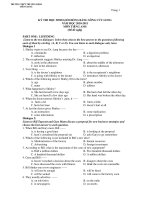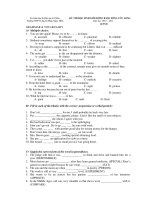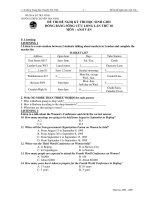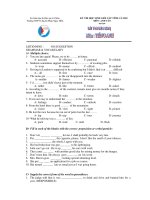KỲ THI HỌC SINH GIỎI ĐỒNG BẰNG SÔNG CỬU LONG ĐỀ 4 - Trường THPT Chuyên Phan Ngọc Hiển docx
Bạn đang xem bản rút gọn của tài liệu. Xem và tải ngay bản đầy đủ của tài liệu tại đây (170.69 KB, 3 trang )
Sở Giáo dục & Đào tạo Cà Mau KỲ THI HỌC SINH GIỎI ĐỒNG BẰNG SÔNG CỬU LONG- ĐỀ 4
Trường THPT Chuyên Phan Ngọc Hiển Năm học 2010 – 2011
READING
Fill in each blank with ONE suitable word.
Modern advertisements contain hidden (1) ___ message ____. Implicit in the
advertisement showing the pretty girl in the new car, or the smiling children round the packet
of washing powder is the message (2) ___ that ____ if we buy the product, we also achieve
success and happiness. It is a subtle approach since it seeks to (3) ___ exploit ____ our secret
dreams, and it is inescapable since adver-ising is ubiquitous. (4) ___ huge ____ street
billboards and catchy jingles on television bombard us from all sides . They brainwash us into
believing that we can realize our ambitions quickly and easily. On the other hand, (5) ___
defenders ____ of advertising say that it is beneficial. Advertising is informative .
Advertisements tell us about useful new products. They (6) ___ brighten ____ our lives with
color and music. They increase demand , (7)___ stimulate ____ industry and so keep prices
down . Whether for or against (8) ___ advertising ____, most people would agree that some
kind of supervision body, appointed by the government or by the advertising industry (9) ___
itself ____, is necessary to maintain (10) ___ standard ____ of honesty and to discourage
the more blatant types of misleading advertisements.
Fill in each numbered blank with one suitable word or phrase.
Researchers in communication show that more feelings and intentions are (1) _______
and received nonverbally than verbally. Mehrabian and Wienerfollowing have stated that only
7% (2) _______ message is sent through words, with remaining 93% sent nonverbal (3)
_______.
Humans use nonverbal communication because:
1. Words have limitations: There are (4) _______ areas where nonverbal communication
is more (5) _______ than verbal, especially when we explain the shape, directions,
personalities which are expressed nonverbally.
2. Nonverbal signal are powerful: Nonverbal cues primarily express inner (6) _______
while verbal messages deal basically with outside world.
3. Nonverbal message are likely (7) _______ more genuine: because nonverbal
behaviors cannot be controlled as easily as spoken words.
4. Nonverbal signals can express feelings inappropriate to state: Social etiquette limits
(8) _______ can be said, but nonverbal cues can communicate thoughts.
5. A separate communication channel is necessary to (9) _______ send complex
messages: A speaker can add enormously to the complexity of the verbal message through
simple nonverbal (10) _______
1. a. sent b. posted c. mailed d. thrown
2. a. through b. in c. of d. for
3. a. thought b. expressions c. gestures d. postures
4. a. sum b. great deal c. amount d. numerous
5. a. effect b. effective c. effectively d. effectiveness
6. a. feelings b. words c. shows d. sorrows
7. a. be b. being c. to be d. been
8. a. what b. that c. why d. when
9. a. get b. have c. make d. help
10. a. signs b. signals c. sight d. signatures
Fill in each numbered blank with one suitable word or phrase.
In the western customs (1) _____ hands is the customary form of greeting, but in China
a nod of the head or (2) _____ bow is sufficient. Hugging and kissing when greeting are
uncommon. Business cards are often (3) _____ and yours should be printed in your own
language and in Chinese. Also, it is more respectful to present your card or a gift or -any other
article using (4) _____ hands. The Chinese are (5) _____ applauders. You may be greeted
with group clapping, even by small children. When a person is applauded in this practice it is
the custom for that person to return the applause or a "thank you." When walking in public
places, direct eye (6) _____ .and staring is uncommon in the larger cities, especially in those
areas accustomed to foreign visitors. (7) _____, in smaller communities, visitors may be the
subject of much curiosity and therefore you may notice some stares. (8) _____ speaking, the
Chinese are not a touch-oriented society, especially true for visitors. So, avoid (9) _____ or
any prolonged form of body contact. Public displays of affection are very rare. On the other
hand, you may note people of the same sex walking hand-in-hand, which is simply a gesture
of friendship. Do not worry about a bit of pushing and shoving in stores or when groups board
public buses or trains. In this case, (10) _____ are neither offered or expected. The Chinese
will stand much closer than Westerners.
1. a. taking b. shaking c. grasping d. hugging
2. a. small b. bit c. slight d. light
3. a. exchanged b. changed c. transferred d. converted
4. a. pair b. couple c. double d. both
5. a. enthusiast b. enthusiastic c. enthusiasm d. enthusiastically
6. a. contact b. look c. stare d. watch
7. a. Moreover b. Furthermore c. However d. Whatever
8. a. Generally b. Successfully c. Fortunately d. Expectedly
9. a. touch b. to touch c. touched d. touching
10. a. Contacts b. Apologies c. Gestures d. Saying goodbye
Read the passage carefully and choose the correct answer.
University Entrance Examination is very important in Vietnamese students. High school
graduates have to take it and get high results to be admitted to universities. The pressure on
the candidates remains very high despite the measures that have been taken to reduce the heat
around these exams, since securing a place in a state university is considered a major step
towards a successful career for young people, especially those from rural areas or
disadvantaged families. In the year 2004, it was estimated that nearly 1 million Vietnamese
students took the University Entrance Examination, but on average only 1 out of 5 candidates
succeeded. Normally, candidates take 3 exam subjects, and each lasts 180 minutes for the
fixed group of subjects they choose. There are 4 fixed groups of subjects: Group A:
Mathematics, Physics, and Chemistry; Group B: Mathematics, Biology, and Chemistry;
Group C: Literature, History, and Geography; Group D: Literature, Foreign Language, and
Mathematics.
In addition to universities, there are community colleges, art and technology institutes;
professional secondary schools, and vocational schools which offer degrees or certificates
from a-few-month to 2-year courses.
According to Vietnam's Ministry of Education and Training, there are currently 23 non-
public universities, accounting for 11% of the total number of universities. These non-public
universities are currently training 119,464 students, or 11.7% of the total number of students.
The government is planning to increase the number of non-public universities to 30% by
2007.
1. University Entrance Examination in Vietnamese is very _______.
a. interesting b. stressful c. free d. easy
2. The word those refers to _______.
a. exam subjects b. young people c. universities d. examinations
3. In 2004, the proportion of the students who got success in University Entrance
Examination was about _______ percent.
a. 5 b. 10 c. 20 d. 50
4. Which sentence refers to the University Entrance Examination in Vietnam?
a. Students find it easy to get success in the University Entrance Examination.
b. Math is compulsory in the University Entrance Examination.
c. Students are not allowed to choose their exam subjects.
d. There are four fixed groups of exam subjects for students to choose.
5. According to the passage, _______.
a. the Vietnamese government will close all non-public universities by next year.
b. the Vietnamese government does not appreciate non-public universities
c. the Vietnamese government encourages the establishing of non-public universities.
d. Vietnamese students have no alternative to continue their higher study besides
universities.









